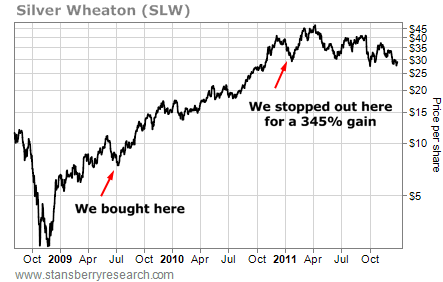No one saw the bloodshed that was coming…
In the summer of 2008, I spent three weeks in Vancouver, home to the thousands of junior resource companies that trade on the TSX Venture Composite Index.
[ad#Google Adsense 336×280-IA]While I was there, I spoke to dozens of industry insiders, geologists, and mining executives. Many of these folks make their living speculating in junior mining stocks. But no one knew what was coming.
Just six months later, the Venture Index had dropped nearly 75%. Most resource investors were caught with their pants down.
They didn’t have exit strategies in place. Everyone was too caught up in the moment.
“It’ll come back,” they said.
The smart investors didn’t lose a wink of sleep. They took their profits and cut their losses early. Everybody else watched millions of dollars in profits evaporate. They rode their stocks all the way down. High-profile paper millionaires saw their wealth disappear. Some even committed suicide.
But it could have all been avoided. And the solution is so simple and straightforward that it’s almost too hard to believe. Let me explain…
When it comes to investing, many people are their own worst enemies. They sell their winners too early and hold on to losing positions because they don’t want to admit they were wrong.
Fortunately, one simple strategy can both reduce your risk AND maximize your returns. This strategy has helped my Stansberry Resource Report subscribers book huge gains over the years. It also kept us from taking big losses over and over again in the resource bear markets of 2007-2009 and 2011-2015.
I’m talking about trailing stops. It’s the idea that you’ll sell a stock when it falls a certain percentage from its high. And it’s easy to calculate. For example, let’s say you buy a stock for $10 and set a 25% trailing stop. Shares go up to $20, and you’re sitting on a 100% gain. But the stock starts to fall. You sell when it hits $15 a share (25% x $20 = $5 | $20 – $5 = $15) and you lock in a 50% gain.
By using a trailing stop, you let your winners run until they stop out. You take the emotion out of investing. This is especially important when trading junior resource stocks, which are among the world’s most volatile assets.
In the Stansberry Resource Report, we’ve used trailing stops to make several triple-digit gains. Take royalty firm Silver Wheaton (SLW), for example…
We recommended SLW shares when they traded for less than $8 per share in July 2009. At that time, shares were volatile. To make sure we didn’t get “whipsawed” out of the trade, we started with a 50% trailing stop.
As you can see in the following chart, shares rose almost straight up after we bought, hitting more than $40 a share. But the stock began to sputter. By late 2010, we tightened our trailing stop to 10% to make sure we would lock in big gains. In January 2011, we stopped out at $34.19 per share for a 345% gain.

We followed our exit strategy and booked huge gains in 18 months. The silver price peaked three months later. Many investors hung on to their shares until it was too late. Silver Wheaton shares were trading down to $22 by early 2012 and bottomed at $10.04 per share in January. If you just kept holding on, you would have coughed up almost all of your gains.
That’s the great thing about trailing stops. They remove the emotion of investing and give you an exact exit point. And that helps us ensure we don’t lose our hard-earned gains.
Resource stocks are cyclical. They go up and they come back down. If you want to succeed as a natural resource investor, you MUST use trailing stops. It’s the only way to profit consistently.
Good investing,
Matt Badiali
[ad#stansberry-ps]
Source: Growth Stock Wire
